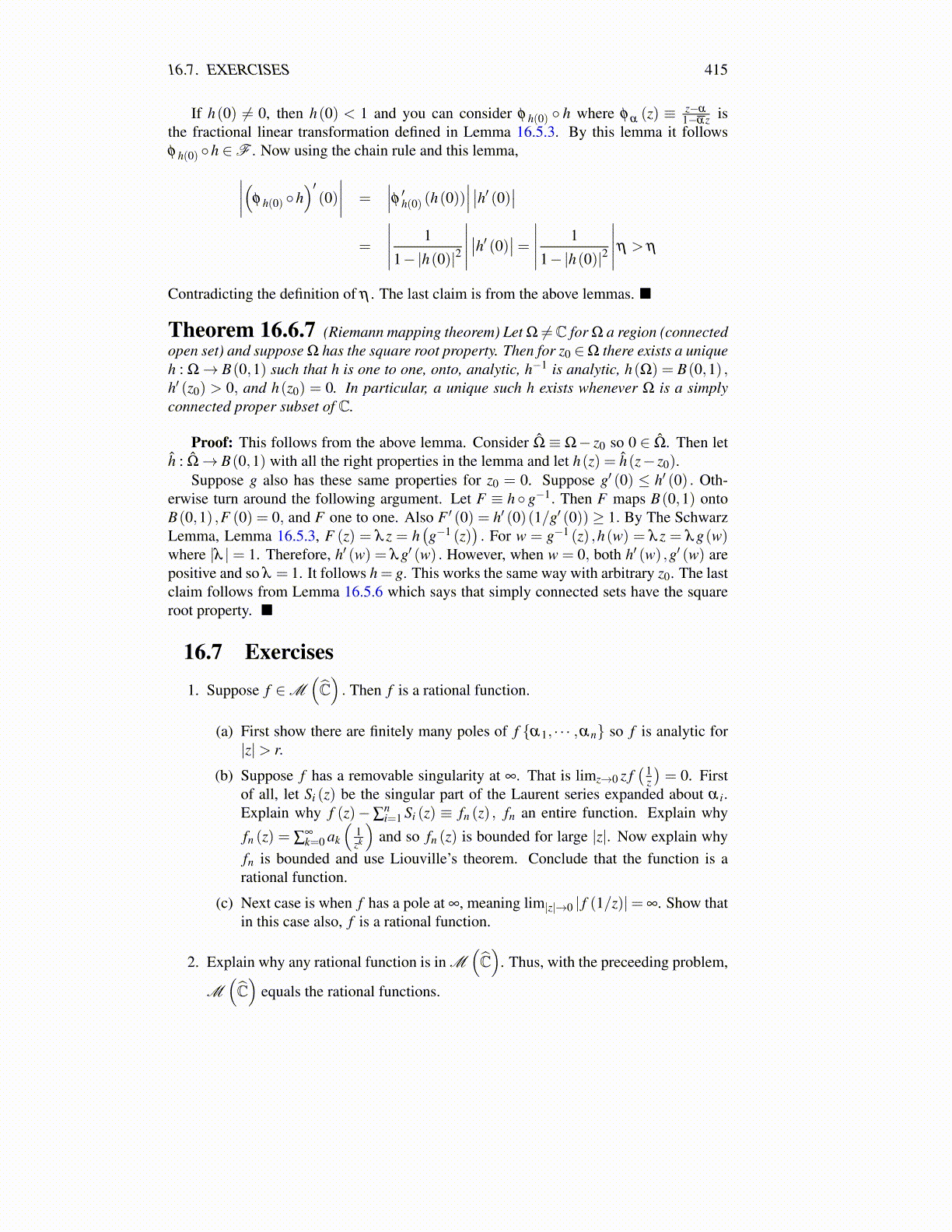
16.7. EXERCISES 415
If h(0) ̸= 0, then h(0) < 1 and you can consider φ h(0) ◦ h where φ α (z) ≡ z−α
1−αz isthe fractional linear transformation defined in Lemma 16.5.3. By this lemma it followsφ h(0) ◦h ∈F . Now using the chain rule and this lemma,∣∣∣∣(φ h(0) ◦h
)′(0)∣∣∣∣ =
∣∣∣φ ′h(0) (h(0))∣∣∣ ∣∣h′ (0)∣∣=
∣∣∣∣∣ 1
1−|h(0)|2
∣∣∣∣∣ ∣∣h′ (0)∣∣=∣∣∣∣∣ 1
1−|h(0)|2
∣∣∣∣∣η > η
Contradicting the definition of η . The last claim is from the above lemmas. ■
Theorem 16.6.7 (Riemann mapping theorem) Let Ω ̸=C for Ω a region (connectedopen set) and suppose Ω has the square root property. Then for z0 ∈Ω there exists a uniqueh : Ω→ B(0,1) such that h is one to one, onto, analytic, h−1 is analytic, h(Ω) = B(0,1) ,h′ (z0) > 0, and h(z0) = 0. In particular, a unique such h exists whenever Ω is a simplyconnected proper subset of C.
Proof: This follows from the above lemma. Consider Ω̂ ≡ Ω− z0 so 0 ∈ Ω̂. Then letĥ : Ω̂→ B(0,1) with all the right properties in the lemma and let h(z) = ĥ(z− z0).
Suppose g also has these same properties for z0 = 0. Suppose g′ (0) ≤ h′ (0) . Oth-erwise turn around the following argument. Let F ≡ h ◦ g−1. Then F maps B(0,1) ontoB(0,1) ,F (0) = 0, and F one to one. Also F ′ (0) = h′ (0)(1/g′ (0))≥ 1. By The SchwarzLemma, Lemma 16.5.3, F (z) = λ z = h
(g−1 (z)
). For w = g−1 (z) ,h(w) = λ z = λg(w)
where |λ | = 1. Therefore, h′ (w) = λg′ (w) . However, when w = 0, both h′ (w) ,g′ (w) arepositive and so λ = 1. It follows h = g. This works the same way with arbitrary z0. The lastclaim follows from Lemma 16.5.6 which says that simply connected sets have the squareroot property. ■
16.7 Exercises1. Suppose f ∈M
(Ĉ). Then f is a rational function.
(a) First show there are finitely many poles of f {α1, · · · ,αn} so f is analytic for|z|> r.
(b) Suppose f has a removable singularity at ∞. That is limz→0 z f( 1
z
)= 0. First
of all, let Si (z) be the singular part of the Laurent series expanded about α i.Explain why f (z)−∑
ni=1 Si (z) ≡ fn (z) , fn an entire function. Explain why
fn (z) = ∑∞k=0 ak
(1zk
)and so fn (z) is bounded for large |z|. Now explain why
fn is bounded and use Liouville’s theorem. Conclude that the function is arational function.
(c) Next case is when f has a pole at ∞, meaning lim|z|→0 | f (1/z)|= ∞. Show thatin this case also, f is a rational function.
2. Explain why any rational function is in M(Ĉ)
. Thus, with the preceeding problem,
M(Ĉ)
equals the rational functions.